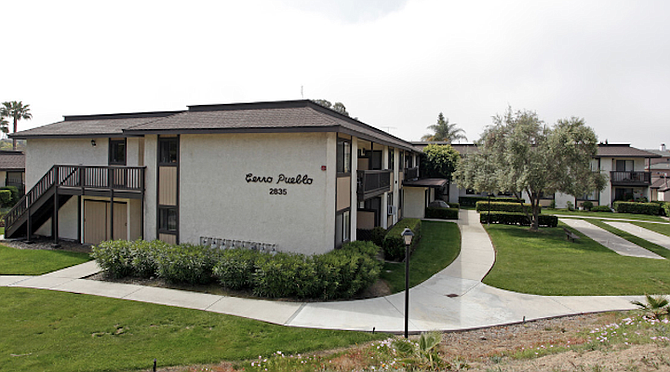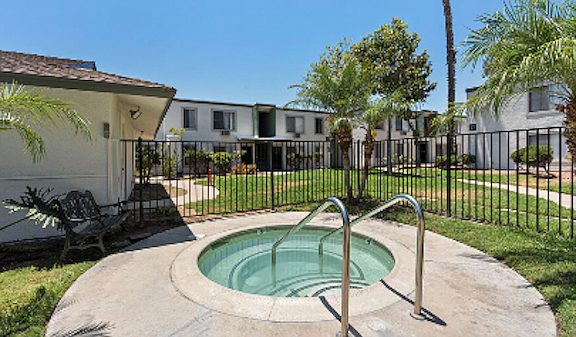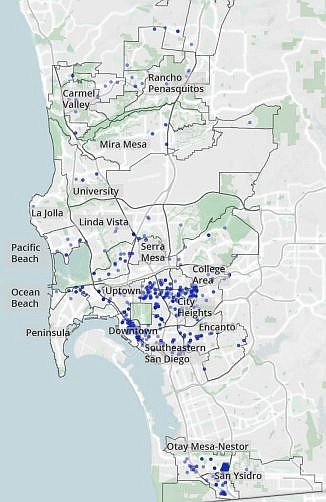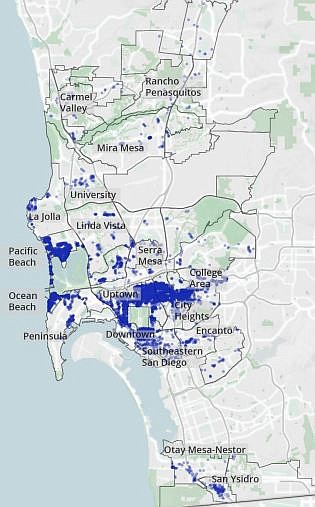 Facebook
Facebook
 X
X
 Instagram
Instagram
 TikTok
TikTok
 Youtube
Youtube

San Diego can't just build its way out of a housing emergency. It has to hold on to its existing affordable homes – an effort the city is slowly phasing in as it grapples with money.
By the end of the year, a draft housing preservation ordinance should finally be ready; one of many recommendations from a Housing Commission study back in 2020.
So-called affordable homes allow those with lower incomes to spend less than 30 percent of their income on housing. Given so few cheap rentals in San Diego, the city would subsidize below-market housing for households that qualify.

There are about 555,000 housing units in the city, nearly half of them occupied by renters. Some of these, like Cerro Pueblo in Bay Park, have restrictions on their deeds that require them to be affordable to specified income levels.
But eventually, these restrictions expire.
Every year, 672 of the city's deed-restricted homes are at risk of losing their affordability, which the city defines as affordable for households earning 60 percent or less of San Diego's median income - which in 2022 was $106,900. In other words, households earning less than $64,140 could not afford these places.
Without actions to preserve their below-market rents, more than 6,600 deed-restricted units in communities from Hillcrest to the College area could be gone by 2033. The total cost to preserve them, A 2020 Housing Commission study estimates, is $400 million per year.

Another 48,000 or so units have no restrictions, but are considered naturally affordable. The city has no database for these homes, but says they may be at risk of increasing to market rate rents.
Sometimes they are sold, and rents shoot up, as happened with dozens of apartments like Conrad Villas, which were sold to the Blackstone Group. Rents there now range from $2208 to $2480/month for two-bedroom units.
The city considers preservation "any action that extends the deed-restricted status of an affordable rental" or "converts an unrestricted naturally occurring affordable" unit to deed-restricted.
Preservation is vital, the city says. According to the housing study, between 2020 and 2040, an average of 750 new deed-restricted units can be expected to be built each year - but at the same time, the affordability of around 4,200 existing restricted units is set to expire, a pace of 200 units a year.
"Approximately 30 percent of all new housing production will simply be replacing units whose affordability status was lost, severely limiting production gains."
Buying and rehabilitating older properties is another part of the city's plan, possibly through the creation of a public-private Affordable Housing Preservation Fund, officials said.

The preservation ordinance, however, seemed to leave out for-profit companies who want to work with the city, prompting numerous objections at a meeting last week of the Land Use and Housing Committee.
"It may need some more work to be a better fit for San Diego," conceded Councilmember Vivian Moreno. As committee chair, she asked the commission to conduct more outreach with some of the affordable housing developers who criticized the apparent exclusion of for-profit developers - a point other committee members agreed on.
Colin Rice, with the RAD Group, whose most recent affordable project is Cerro Pueblo, said it makes no sense to leave out for-profit developers - "at a time in San Diego when it is so critical to have more players, more investors" in affordable housing.
Officials stressed the need for local funding sources, which full implementation of a preservation program will require. A budget allocation of $5.3 million dollars would allow preservation of around 79 units by extending expiring affordable housing deed-restrictions. It could be used to seek matching funds.
The commission has relied on federal, state and local resources to extend affordability, but in recent years, affordable housing funding sources have prioritized new construction.
A preservation ordinance could have several benefits, they said, like expanded notice of expiring deed restrictions under state law. San Diego could require deed-restricted properties to notify the city of an intended sale.
Other perks include giving qualified and nonprofit partners an opportunity to submit an offer to purchase deed-restricted properties for sale. To become "qualified," a for-profit company must certify their capability to own and operate affordable housing, stick to the affordability the property had at purchase, and provide rent restrictions of at least 30 years.
Stephen Russell, president and CEO of San Diego Housing Federation, urged the city to develop a preservation ordinance that follows the recommendations of the May 2020 study. The city needs "some kind of regulatory and financial infrastructure for preservation." He reminded the committee that two years ago, the Conrad Prebys Foundation sold a portfolio of nearly 6,000 units of naturally affordable housing, wiping out the equivalent of almost five years of deed-restricted housing production.
"The continued loss of naturally affordable housing will continue to drive upward the numbers of people who are without homes in our region."


San Diego can't just build its way out of a housing emergency. It has to hold on to its existing affordable homes – an effort the city is slowly phasing in as it grapples with money.
By the end of the year, a draft housing preservation ordinance should finally be ready; one of many recommendations from a Housing Commission study back in 2020.
So-called affordable homes allow those with lower incomes to spend less than 30 percent of their income on housing. Given so few cheap rentals in San Diego, the city would subsidize below-market housing for households that qualify.

There are about 555,000 housing units in the city, nearly half of them occupied by renters. Some of these, like Cerro Pueblo in Bay Park, have restrictions on their deeds that require them to be affordable to specified income levels.
But eventually, these restrictions expire.
Every year, 672 of the city's deed-restricted homes are at risk of losing their affordability, which the city defines as affordable for households earning 60 percent or less of San Diego's median income - which in 2022 was $106,900. In other words, households earning less than $64,140 could not afford these places.
Without actions to preserve their below-market rents, more than 6,600 deed-restricted units in communities from Hillcrest to the College area could be gone by 2033. The total cost to preserve them, A 2020 Housing Commission study estimates, is $400 million per year.

Another 48,000 or so units have no restrictions, but are considered naturally affordable. The city has no database for these homes, but says they may be at risk of increasing to market rate rents.
Sometimes they are sold, and rents shoot up, as happened with dozens of apartments like Conrad Villas, which were sold to the Blackstone Group. Rents there now range from $2208 to $2480/month for two-bedroom units.
The city considers preservation "any action that extends the deed-restricted status of an affordable rental" or "converts an unrestricted naturally occurring affordable" unit to deed-restricted.
Preservation is vital, the city says. According to the housing study, between 2020 and 2040, an average of 750 new deed-restricted units can be expected to be built each year - but at the same time, the affordability of around 4,200 existing restricted units is set to expire, a pace of 200 units a year.
"Approximately 30 percent of all new housing production will simply be replacing units whose affordability status was lost, severely limiting production gains."
Buying and rehabilitating older properties is another part of the city's plan, possibly through the creation of a public-private Affordable Housing Preservation Fund, officials said.

The preservation ordinance, however, seemed to leave out for-profit companies who want to work with the city, prompting numerous objections at a meeting last week of the Land Use and Housing Committee.
"It may need some more work to be a better fit for San Diego," conceded Councilmember Vivian Moreno. As committee chair, she asked the commission to conduct more outreach with some of the affordable housing developers who criticized the apparent exclusion of for-profit developers - a point other committee members agreed on.
Colin Rice, with the RAD Group, whose most recent affordable project is Cerro Pueblo, said it makes no sense to leave out for-profit developers - "at a time in San Diego when it is so critical to have more players, more investors" in affordable housing.
Officials stressed the need for local funding sources, which full implementation of a preservation program will require. A budget allocation of $5.3 million dollars would allow preservation of around 79 units by extending expiring affordable housing deed-restrictions. It could be used to seek matching funds.
The commission has relied on federal, state and local resources to extend affordability, but in recent years, affordable housing funding sources have prioritized new construction.
A preservation ordinance could have several benefits, they said, like expanded notice of expiring deed restrictions under state law. San Diego could require deed-restricted properties to notify the city of an intended sale.
Other perks include giving qualified and nonprofit partners an opportunity to submit an offer to purchase deed-restricted properties for sale. To become "qualified," a for-profit company must certify their capability to own and operate affordable housing, stick to the affordability the property had at purchase, and provide rent restrictions of at least 30 years.
Stephen Russell, president and CEO of San Diego Housing Federation, urged the city to develop a preservation ordinance that follows the recommendations of the May 2020 study. The city needs "some kind of regulatory and financial infrastructure for preservation." He reminded the committee that two years ago, the Conrad Prebys Foundation sold a portfolio of nearly 6,000 units of naturally affordable housing, wiping out the equivalent of almost five years of deed-restricted housing production.
"The continued loss of naturally affordable housing will continue to drive upward the numbers of people who are without homes in our region."
Comments